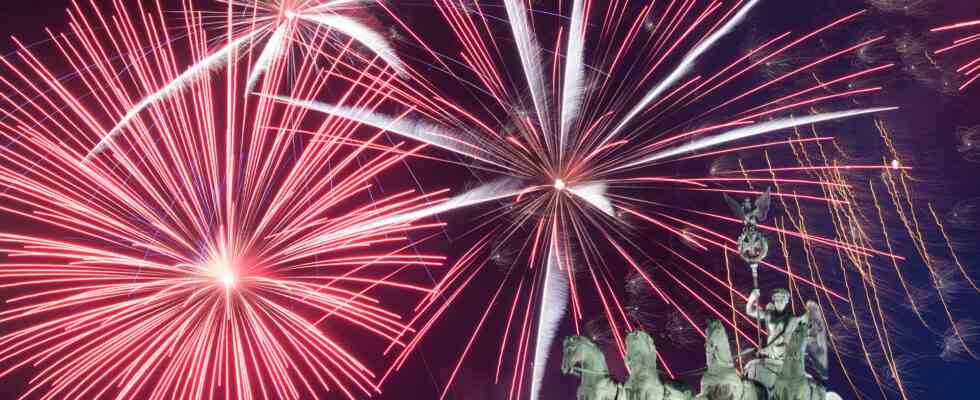Status: 12/28/2022 2:41 p.m
Fireworks have been produced in Augsburg since 1863. But the business model is under scrutiny: Firecrackers are considered unhealthy and harmful to the environment. How does the family business deal with this?
No assembly line, no large factory building, not even a visible company sign. Instead, 27 small concrete houses that look as old as they are and are spread over an area the size of eight football pitches. In between some old trees. The Feuerwerk-Sauer production facility in Augsburg looks like it has fallen out of time.
The reason for this is not a lack of will to innovate, but the physical properties of black powder. “Certain safety distances are prescribed for the individual production steps, then as now,” explains Peter Sauer, who is the fifth generation to run the company, which was founded in 1863. That is why work is still being done in the small concrete houses, which must be at least 15 meters apart.
Pandemic forces realignment
When the corona virus paralyzed Germany in 2020, the fireworks industry suffered alongside many sectors. New Year’s Eve parties are canceled and with them the firecrackers. The sale of fireworks items is even prohibited. Hospitals should not be further burdened, so the argument a year ago. For Peter Sauer and his team, this means a slump in the cash register. “We only earned a third of what we used to earn.”
The fact that they are still making any money at all is because Sauer is realigning its operations. For example, he now relies on signal flares. They are made by Marion Nagy, who in one of the cottages uses long, thin cardboard tubes to make the torches that are then sold to the police. “A police officer reported to me that the electronic flashing lights are regularly run over. But everyone brakes with a burning torch,” says Sauer.
In the fifth generation in the fireworks industry – Peter Sauer (right) cannot imagine life without rockets and firecrackers.
Image: BR
“Please be quiet, environmentally friendly and animal-friendly”
But of course a man whose family has been surrounded by gun smoke for 150 years cannot give up his core business overnight. So he still makes fireworks items today. For a market that, like so many others, is dominated by China. And which has been viewed more and more critically in recent years.
Because fireworks are no longer just meant to arouse amazement. It should also be quiet, environmentally sustainable and animal-friendly. “Plastic has been largely eliminated and replaced by cardboard. And if it has to be more stable, clay is used. That’s an important topic in the industry. A lot has happened in recent years,” says Sauer, who primarily works as a professional making fireworks.
Particulate matter also affects animals
The problem with fine dust remains: Every year around 2050 tons of fine dust are released by burning fireworks, most of them on New Year’s Eve, writes the Federal Environment Agency. This corresponds to about one percent of the total amount of fine dust released in Germany. In the hours after midnight in particular, very high measured values occur on an hourly average. There is talk of several thousand micrograms per cubic meter.
Sauer does not want to deny the problem. His own bronchi are affected by decades of working in the smoke of firecrackers. But one shouldn’t dramatize the subject either. “Apart from the bronchial problems, I’m healthy. And I got a lot of fine dust.” For the general public, the burden only occurs in the hours after the turn of the year.
Environmental organizations take a critical view of such statements. Especially since animals also suffer from the fireworks. In addition to pets, birds in particular are affected, writes the German Nature Conservation Union: “They flee to much higher altitudes, do not land for a long time and often leave their resting and sleeping areas for several days. Waterfowl react to fireworks even two to seven kilometers away .”
Fireworks without a bang?
Sauer leads to the company’s test site and anchors a tube construction in the ground – the launching device for category F4 professional fireworks. Then he puts several balls wrapped in thin cardboard into the tubes. “We’re going to do a test now. First we shoot up a conventional firework display and then a quiet product from China.”
Sauer telephoned the fire brigade and his neighbors about the planned test, grabbed the electronic detonator and moved about 80 meters from the launcher. Then he counts to three and ignites. Meters high, sparks and flames shoot out of the pipe. A glowing ball rises into the sky, which explodes with a loud bang. Golden effects fly like stars in the evening sky. That was the loud product.
Then the quiet. Three, two, one, Peter Sauer ignites. Sparks fly again. But instead of a bang, there is now a much quieter pop. No star effect. Instead, colorful balls fall down. “It was quieter because the decomposition force is lower, the explosive charge was smaller.” A number of customers for whom Sauer organizes large fireworks displays have now asked for such quiet products. “A little quieter, please, but just as beautiful as usual. That’s the wish.” But he cannot fulfill this wish with his products.

